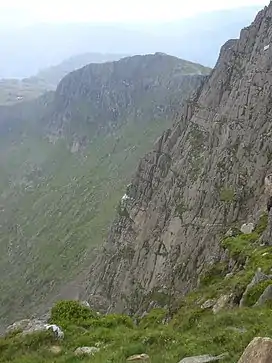Y Lliwedd
Y Lliwedd is a mountain, connected to Snowdon in the Snowdonia National Park, North Wales.
| Y Lliwedd | |
|---|---|
 Y Lliwedd from Snowdon | |
| Highest point | |
| Elevation | 898 m (2,946 ft) |
| Prominence | 154 m (505 ft) |
| Parent peak | Snowdon |
| Listing | Marilyn, Hewitt, Nuttall |
| Coordinates | 53°03′36″N 4°03′25″W |
| Naming | |
| English translation | colourless peak |
| Language of name | Welsh |
| Pronunciation | Welsh: [ə ˈɬɪwɛð] |
| Geography | |
| Location | Gwynedd, Wales |
| Parent range | Snowdonia |
| OS grid | SH622533 |
| Topo map | OS Landranger 115 |
| Name | Grid ref | Height | Status |
|---|---|---|---|
| Y Lliwedd East Peak | 893 m (2,930 ft) | Nuttall | |
| Lliwedd Bach | 818 m (2,684 ft) | Nuttall | |
| Gallt y Wenallt | 619 m (2,031 ft) | Hewitt, Nuttall |
Its summit lies 898 metres (2,946 ft) above sea level.
The eastern flanks are steep cliffs rising above Glaslyn and Llyn Llydaw. Y Lliwedd is the most conspicuous of the peaks for those who approach Snowdon via the Miners' and Pyg tracks. Few that summit Snowdon continue over to Y Lliwedd as the challenge of Wales' highest peak is enough, leaving Y Lliwedd quiet and peaceful even when queues are forming at the summit of Snowdon.
Hikers and mountaineers often pass over Y Lliwedd when walking the Snowdon Horseshoe. The noted British climber George Mallory undertook many of his early climbs here. It was also the site of considerable training activity for the 1953 British Everest Expedition.
The north face of Y Lliwedd was explored in the late 19th century and in 1909 was the subject of the first British climbing guide, The Climbs on Lliwedd by J. M. A. Thomson and A. W. Andrews.
Two subsidiary peaks of Y Lliwedd are listed as Nuttalls: Lliwedd Bach 818 metres (2,684 ft): SH628532 and Y Lliwedd East Peak 893 metres (2,930 ft): SH623532.[1]
References
- Nuttall, John & Anne (1999). The Mountains of England & Wales - Volume 1: Wales (2nd edition ed.). Milnthorpe, Cumbria: Cicerone. ISBN 1-85284-304-7.


